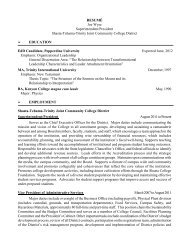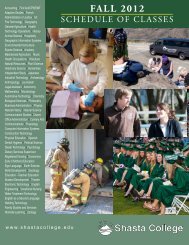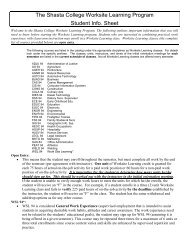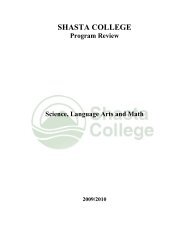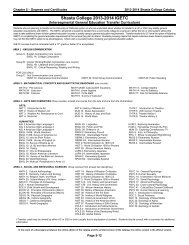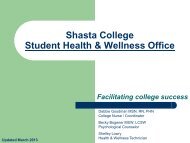24The hypothesis that I and others have advanced is that it ispossible, but only if we approach the teaching of science like ascience. That means applying to science teaching the practicesthat are essential components of scientific research and thatexplain why science has progressed at such a remarkable pacein the modem world.The most important of these components are:• Practices and conclusions based on objective data ratherthan-as is frequently the case in education-anecdote or tradition.This includes using the results of prior research, such aswork on how people learn.• Disseminating results in a scholarly manner and copyingand building upon what works. Too often in education, particularlyat the postsecondary level, everything is reinvented,often in a highly flawed form, every time a different instructorteaches a course. (I call this problem "reinventing the squarewheel.")• Fully utilizing modem technology. Just as we are alwayslooking for ways to use technology to advance scientific research,we need to do the same in education.These three essential components of all experimental scientificresearch (and, not incidentally, of the scholarship of teachingand learning) can be equally valuable in science education.Applied to the teaching of science, they have the capability todramatically improve both the effectiveness and the efficiencyof our educational system.THE LEARNING PUZZLEWhen I first taught physics as a young assistant professor,I used the approach that is all too common when someone iscalled upon to teach something. First I thought very hard aboutthe topic and got it clear in my own mind. Then I explained itto my students so that they would understand it with the sameclarity I had.At least that was the theory. But I am a devout believer in theexperimental method, so I always measure results. (See Figure2.) And whenever I made any serious attempt to determinewhat my students were learning, it was clear that this approachjust didn't work. An occasional student here and there mighthave understood my beautifully clear and clever explanations,but the vast majority of students weren't getting them at all.Figure 2. Student reaction to my brilliantlyclear explanations.rr~rrrrrrrrrrrrr~??????????????????????????????????????????For many years, this failure of students to learn from myexplanations remained a frustrating puzzle to me, as I think itis for many diligent faculty members. What eventually led meto understand it was that I was encountering the even biggerpuzzle of my graduate students.I have conducted an extensive research program in atomicphysics over many years that has involved many graduate10students, on whose professional development I have spent alot of time and thought. And over the years I became awareof a consistent pattern. New graduate students would come towork in my laboratory after 17 years of extraordinary successin classes, but when they were given research projects to workon, they were clueless about how to proceed. Or worse--oftenit seemed that they didn't even really understand what physicswas.But then an amazing thing happened: After just a few yearsof working in my research lab, interacting with me and theother students, they were transformed. I'd suddenly realizethey were now expert physicists, genuine colleagues. If thishad happened only once or twice it would have just seemed anoddity, but I realized it was a consistent pattern. So I decided tofigure it out.One hypothesis that occurred to me, as it has to many otherresearch advisors who have observed similar transformations,is that the human brain has to go through a 17-year "caterpillar"stage before it is suddenly transformed into a physicist"butterfly." (See Figure 3.) But I wasn't satisfied with thatexplanation, so I tackled it like a science problem. I startedstudying the research on how people learn, particularly howthey learn science, to see if it could provide a more satisfactoryexplanation of the pattern. Sure enough, the research did haveanother explanation to offer that also solved the earlier puzzleof why my classroom teaching was ineffective.Figure 3. Brain-development possibility: 17 years asintellectual caterpillar before transformation intophysicist butterfly?7qRESEARCH ON LEARNINGIn a traditional science class, the teacher stands at the frontof the class lecturing to a largely passive group of students.Those students then go off and do back-of-the-chapter homeworkproblems from the textbook and take exams that are similarto those exercises.The research has several things to say about this pedagogicalstrategy, but I'll focus on three findings-the first aboutthe retention of information from lecture, the second about understandingbasic concepts, and the third about general beliefsregarding science and scientific problem-solving. The data Idiscuss were mostly gathered in introductory college physicscourses, but these results are consistent with those of similarstudies done in other scientific disciplines and at other gradelevels. This is understandable, because they are consistent withwhat we know about cognition.Retaining lnfonnationLectures were created as a means of transferring informationfrom one person to many, so an obvious topic forCHANGE • SEPTEMBER/OCTOBER 2007
25research is the retention of the information by the many. Theresults of three studies-which can be replicated by any facultymember with a strong enough stomach-are instructive.The first is by Joe Redish, a highly regarded physics profes"sor at the University of Maryland. Even though the studentsthought his lectures were wonderful, Joe wondered how muchthey were actually learning. So he hired a graduate student tograb students at random as they filed out of class at the endof the lecture and ask, "What was the lecture you just heardabout?" It turned out that the students could respond with onlywith the vaguest of generalities.Zdeslav Hrepic, N. Sanjay Rebello, and Dean Zollman atKansas State University carried out a much more structuredstudy. They asked 18 students from an introductory physicsclass to attempt to answer six questions on the physics of soundand then, primed by that experience, to get the answers to thosequestions by listening to a 14-minute, highly polished commercialvideotaped lecture given by someone who is supposed tobe the world's most accomplished physics lecturer. On most ofthe six questions, no more than one student was able to answercorrectly.In a final example, a number of times Kathy Perkins and Ihave presented some non-obvious fact in a lecture along withan illustration, and then quizzed the students 15 minutes lateron the fact. About 10 percent usually remember it by then. Tosee whether we simply had mentally deficient students, I oncerepeated this experiment when I was giving a departmentalcolloquium at one of the leading physics departments in theUnited States. The audience was made up of physics facultymembers and graduate students, but the result was about thesame-around 10 percent.Given that there are thousands of traditional science lecturesbeing given every day, these results are quite disturbing. Dothese findings make sense? Could this meager transfer of informationin lectures be a generic problem?These results do indeed make a lot of sense and probablyare generic, based on one of the most well-established-yetwidely ignored-results of cognitive science: the extremelylimited capacity of the short-term working memory. Theresearchtells us that the human brain can hold a maximum ofabout seven different items in its short-term working memoryand can process no more than about four ideas at once. Exactlywhat an "item" means when translated from the cognitivescience lab into the classroom is a bit fuzzy. But the numberof new items that students are expected to remember and processin the typical hour-long science lecture is vastly greater.So we should not be surprised to find that students are able totake away only a small fraction of what is presented to themin that format.Understanding Basic ConceptsWe physicists believe that one of the great strengths ofphysics is that it has a few fundamental concepts that canbe applied very widely. This has inspired physics~educationresearchers to study how well students are actually learningthe basic concepts in their physics courses, particularly at theintroductory level.These researchers have created some good assessment toolsfor measuring conceptual understanding. Probably the oldestCHANGE • SEPTEMBER/OCTOBER 2007and most widely used of these is the Force Concepts Inventory(FCI) (see Hestenes, 1992 in "Resources" below). This instrumenttests students' mastery of the basic concepts of force andmotion, which are covered in every first-semester postsecondaryphysics course. The FCI is composed of carefully developedand tested questions that usually require students to applythe concepts of force and motion in a real-world context, suchas explaining what happens when a car runs into a truck. TheFCI-now administered in hundreds of courses annually-normallyis given at the beginning and end of the semester to seehow much students have learned during the course.Richard Hake compiled the FCI results from 14 different traditionalcourses and found that in the traditional lecture course,students master no more than 30 percent of the key conceptsthat they didn't already know at the start of the course (SeeFigure 4). Similar sub-30-percent gains are seen in many otherunpublished studies and are largely independent of lecturerquality, class size, and institution. The consistency of thoseresults clearly demonstrates that the problem is in the basicpedagogical approach: The traditional lecture is simply notsuccessful in helping most students achieve mastery of fundamentalconcepts. Pedagogical approaches involving more interactiveengagement of students show consistently higher gainson the FCI and similar tests.Figure 4.o:o 8dSource: Plot from R. Hake, "A six-thousand-student survey," AJP 66, 64-74 ( 1998).Affecting BeliefsStudents believe certain things about what physics is andhow one goes about learning the discipline, as well as how onesolves problems in physics. If you interview a lot of people,you find that their beliefs lie on a spectrum that ranges from"novice" to "expert." My research group and others have developedsurvey instruments that can measure where on this scale aperson's beliefs lie.What do we mean by a "novice" in this context? Adaptingthe characterization developed by David Hammer, novices seethe content of physics instruction as isolated pieces of information-handeddown by an authority and disconnected from theworld around them-that they can only learn by memorization.To the novice, scientific problem-solving is just matching thepattern of the problem to certain memorized recipes.11




